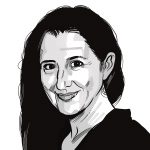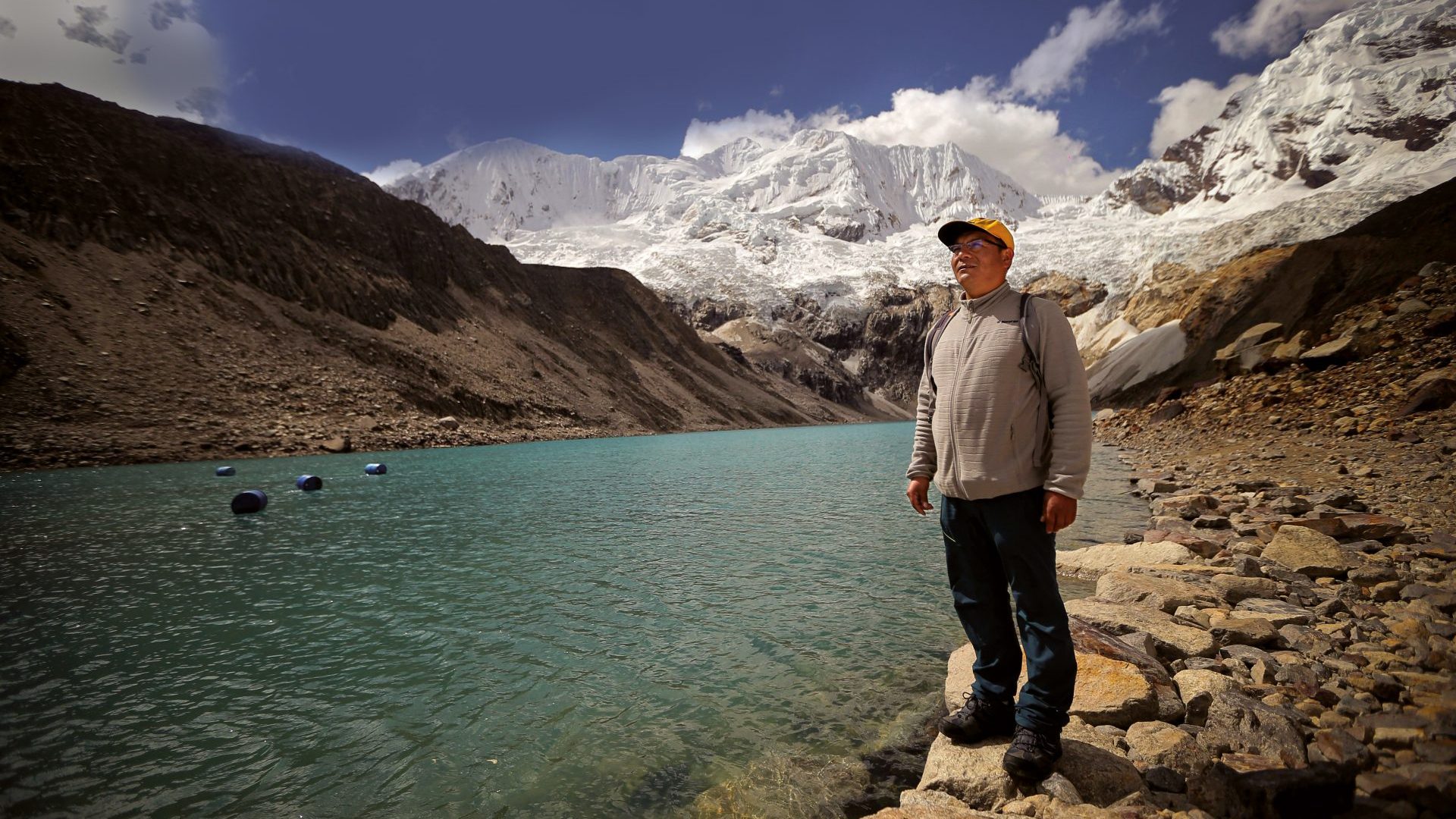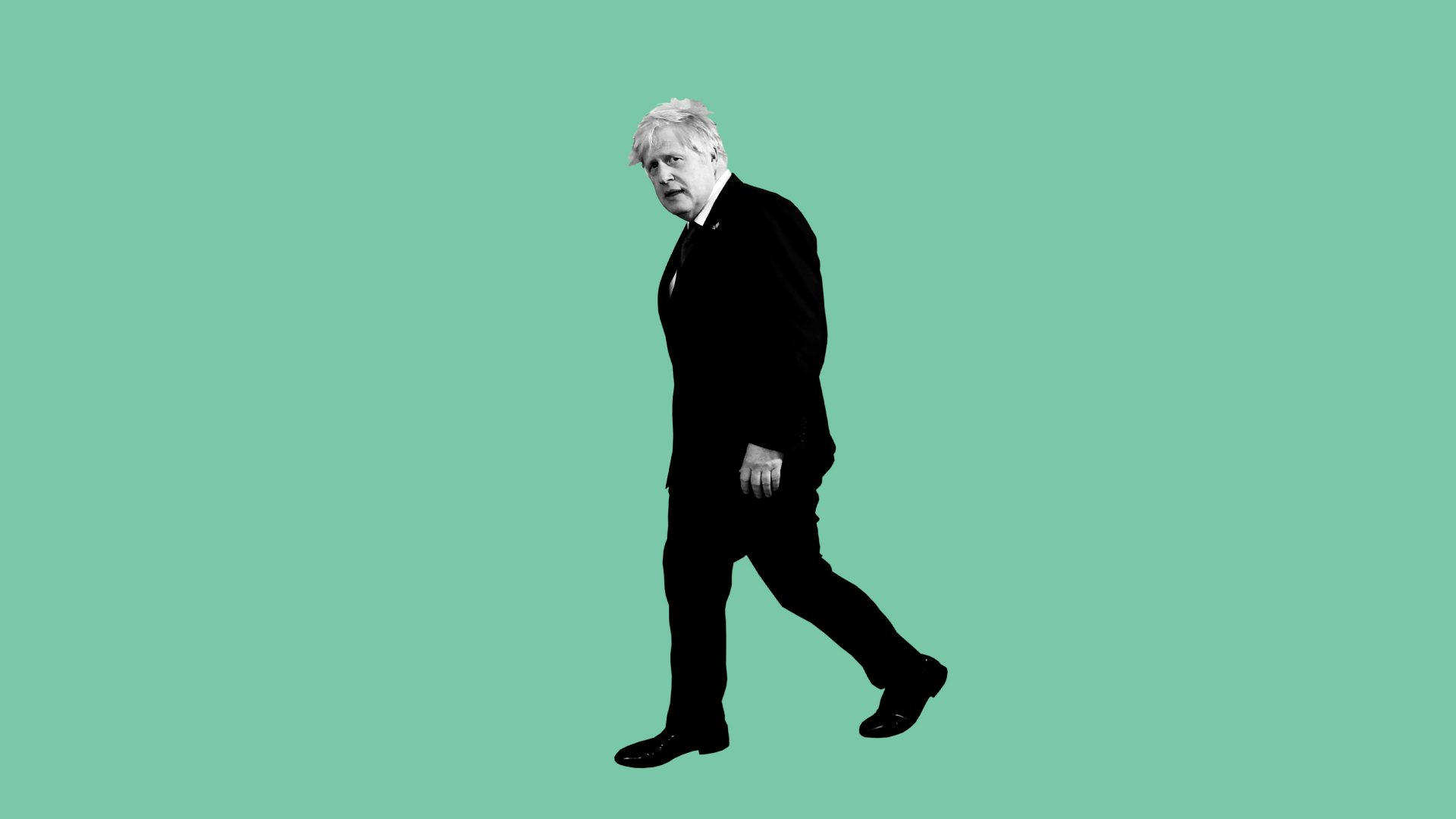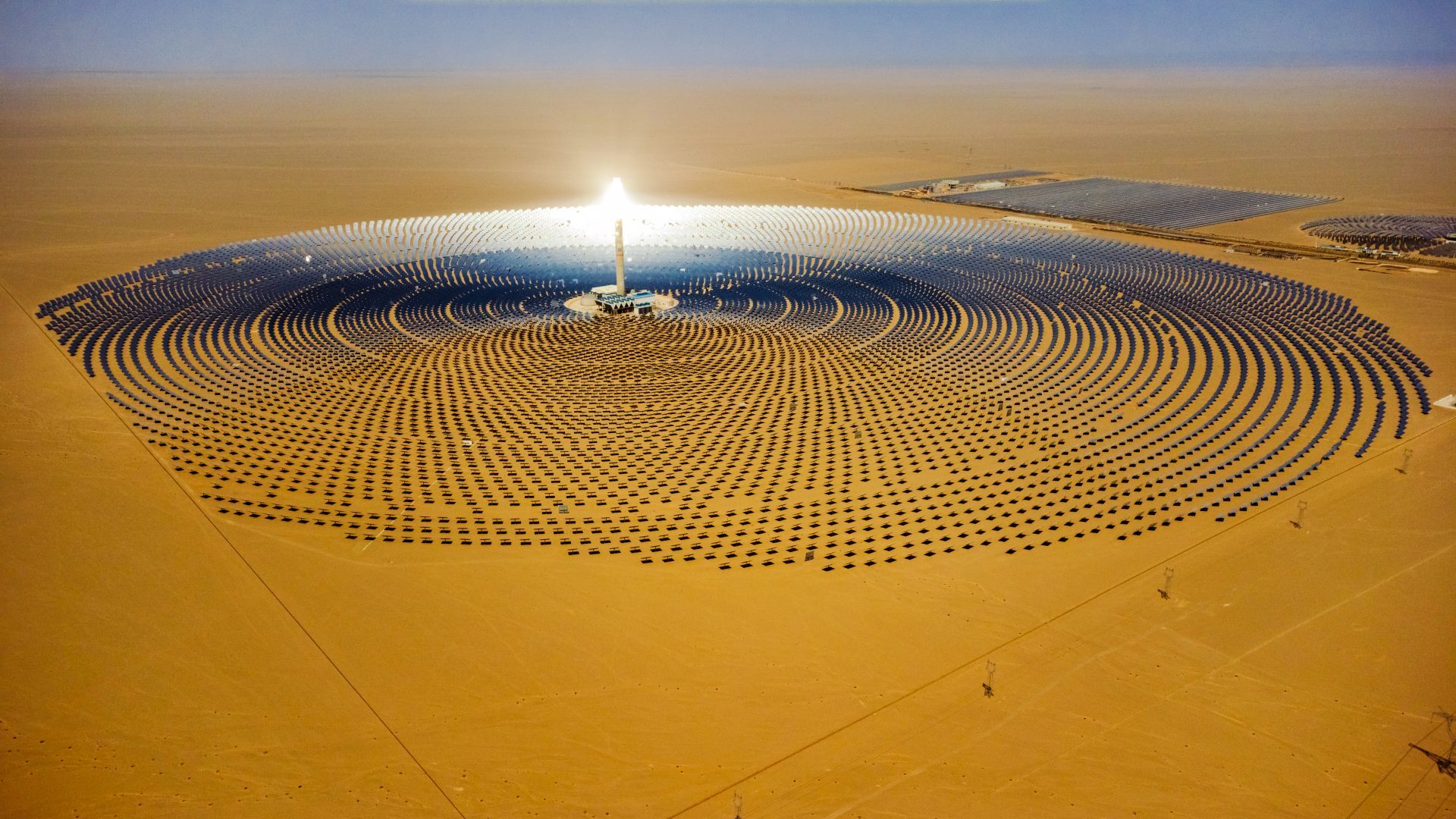“I’ll do it. I’ll do the claim….”
Over a dinner of roast guinea pig with Andean chili sauce, the shy Peruvian mountain guide uncharacteristically raised his voice and volunteered. Everyone turned towards him. His father, Julio, his wife, Lidia, several other family members, three German climate activists and a multilingual young academic – they all smiled. “Right,” said Christoph Bals, head of the environmental charity Germanwatch, “We’re going to court.”
Saul Luciano Lliuya, then 34, who had never left his hometown of Huarez in the foothills of Peru’s Cordillera Bianca mountains, decided on that fateful day in December 2014 to go to Germany and take on energy giant RWE in the courts – the moment above evoked vividly in the forthcoming book and PHD dissertation by Noah Walker Crawford, Germanwatch adviser and University College London postdoctoral research fellow, who was present.
A year later, he was suing the Essen-based company over its role in melting the Palcaraju glacier and posing a danger to his home and livelihood. The landmark case was the first involving an individual asking a big polluting fossil fuel company to compensate for the harm its products caused him.
RWE is based nearly 10,500km away in Essen. It doesn’t even operate in Peru. But campaigners like Walker-Crawford say that does not matter when the company sends over 100m tons of carbon dioxide into the atmosphere every year, making it the second-largest emitter of CO2 in Europe.
“I was a bit scared at the beginning – you read about people fighting to protect rainforests being killed. But it’s a very important case so even with the fear I feel I have to do something,” Saul told me from his home.
For years he had closely watched the glacier melt, dangerously expanding the ample lake below and raising the risk of flood. Glaciers are important sources of water in the mountainous region where they live, and make agriculture possible. Up to 50 percent of glaciers in the tropical Andes have disappeared due to global warming since 1976.
Like many rural Peruvians, Saul sees the mountains as living Earth Beings, now suffering because of humankind. “As a guide I’m very close to the mountains. I see how fast the glaciers retreat and that makes me very sad.”
The lawsuit has been likened to a David and Goliath scenario. But, as described by Walker Crawford there is more than a touch of the Lord of the Rings about it.
A quiet central character surrounded by bigger, more experienced figures unable to take forward the challenge, Saul fits easily into the role of brave, innocent soul fighting for the future of Middle Earth/humanity. And that’s attracted worldwide interest in the story he has to tell about the damage humans do to nature and the global consequences of fossil fuel dependence.
It has special resonance in the year the Intergovernmental Panel on Climate Change (IPCC) released its bleakest report yet, showing the pace of climate change racing ahead of patchy efforts to contain it. UN secretary general António Guterres called it “a damning indictment of failed climate leadership.”
With politicians, international bodies and corporates clearly failing, lawyers sought ways of forcing change through the courts instead. Germanwatch activists, in Lima for Cop20 in 2014, heard Saul’s father’s angry concerns about glacier melt. Eventually, his youngest son, a child of the countryside and the mountains, quietly stepped in. The quest would likely fail, but he had to try.
“We’re trying to do something for the first time in history,” his lawyer, Roda Verheyen, told me from Germany. “This is about justice for the people who have little to do with climate change but are suffering. If we win the case we will have put the polluter pays principle into practice, and there will be a totally different price tag for fossil fuels.”
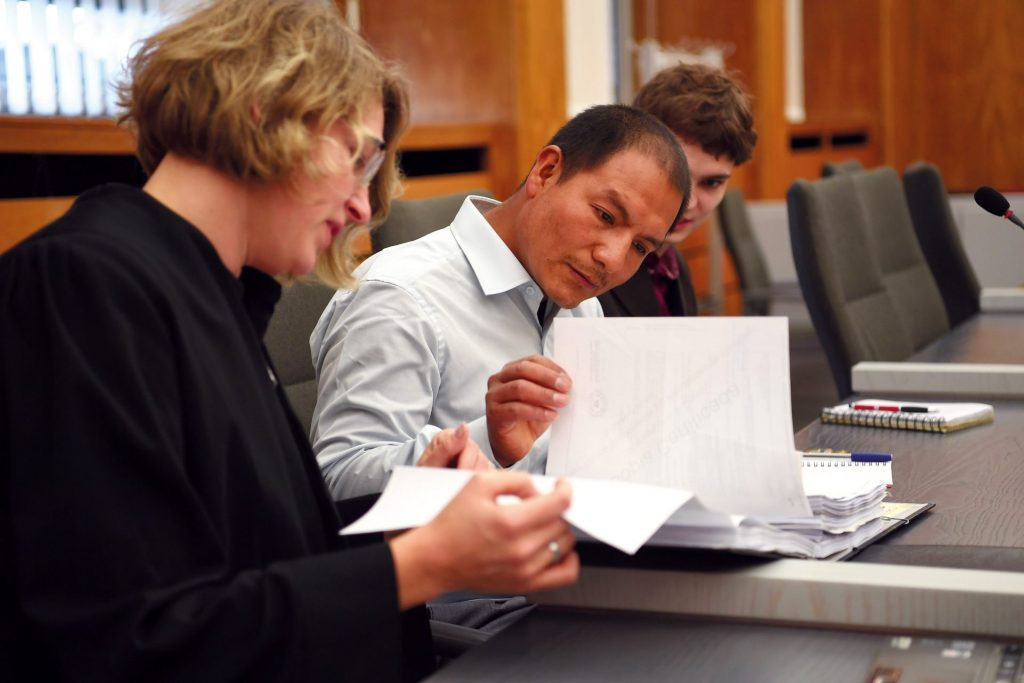
It adds to a growing pool of climate litigation. These include the trailblazing Urgenda case, where an environmental group and 900 citizens forced the Netherlands to speed up its greenhouse gas emission reduction plans. Last year, a court-ordered Royal Dutch Shell to reduce its future worldwide CO2 emissions by 45 percent by 2030.
Today, Saul is closer than ever to throwing the ring into the mountains of Mordor. His lawyers couldn’t promise success and the case was initially rejected. But, in 2017, an appeals court in Hamm surprisingly took it on. Now, the entire court – judges, lawyers, plaintiffs, defendants, experts – is preparing to travel to Saul’s mountain home to ascertain the risk from an avalanche caused by glacier melt making the lake overflow and flood the settlement below.
“The idea is to create a connection between RWE’s activities in Europe over the past 100 years and what’s happening in Peru,” Walker Crawford told me. “It’s the last part of a causal chain.”
Getting here involved a scientific and legal journey encompassing two continents and over a century of academic research. First, the company’s emissions had to be linked to general global warming. So when Richard Heede, of the Climate Accountability Institute, released his pivotal 2017 Carbon Majors Study quantifying the CO2 emissions of companies back to the 1850s, Saul’s lawyers grabbed it with both hands.
Adding to the growing discipline of attribution science, which establishes cause and blame, Heede produced the only database containing global scale emissions at company level. The painstaking process of forensically cataloguing fossil fuel production data through 100 years of official and unofficial company reports, public statements and historical sources determined the proportion of emissions responsibility for each company. He found 20 companies, including Saudi Aramco, Chevron, ExxonMobil, BP and Royal Dutch Shell, had alone produced a third of fossil fuel emissions since 1965, when scientists were already warning of future harms. Since 1988, when climate change was officially recognized, 100 fossil fuel companies were linked to over 70 percent of industrial greenhouse gas emissions.
The most polluting, Aramco, accounted for 4.5 percent of total emissions, RWE for some 0.5 percent — and that’s the basis of Saul’s demand for approximately $20,000 as a fair share of the cost of flood defences and other protection around the Palcaraju glacier lake.
“I was pretty clear that oil and gas corporations and some coal corporations would eventually be held liable and that we had to not only identify them but quantify with robust methodology how much they had actually contributed,” Heede told me.
Clamour for a reckoning is growing, demonstrated vividly by the public resignation of Shell safety consultant Caroline Dennett, who declared: “I can no longer work for a company who ignores all the alarms and dismisses the risks of climate change and ecological collapse.”
Glaciers, which are sensitive indicators for long-term change, are shrinking and disappearing at an alarming rate. The risk to people like Saul isn’t just flooding or avalanches, but water scarcity as once reliable sources evaporate. But while a general link between melting glaciers and global warming is known, something more specific was needed. And that’s what Oxford University’s Rupert Stuart-Smith had been working on – his report on the Palcaraju glacier involved analysis of global and local temperatures over the past 140 years, the glacier’s measurements, the topography of the mountain and lake, and wider climate science.
Even the maximum possible natural variability would have changed the glacier only slightly, he said. Without manmade global warming, “it would have been impossible for the glacier to have retreated anywhere near as much as it did.”
Scientists now have the tools to simulate and analyse what storms, heatwaves and glaciers would have looked like in the absence of climate change, Stuart Smith explained: “Gone are the days when you see in the newspapers that ‘well you can’t attribute any one event to climate change’ — you can, whether it’s a weather event or whether it’s the change of a specific glacier.”
Verheyen says although the danger from the glacier is undeniable – the lake flooded in 1941, destroying a third Huarez, causing 1,800 casualties – proving this within legal parameters is trickier. RWE constantly offers data purporting to show there’s no risk of glacier lake outburst flood locally, and Peruvian officials play down the danger to avoid panic and keep tourists coming. The court is going to the glacier is to assess the immediacy of the risk.
Saul chuckles at the thought of those important people going to his two-storey adobe house. A site visit is usual under Germany’s 1900s nuisance law, but more commonly involves going round the block to see if neighbours are causing a nuisance with smells or other irritants – not half a world away to stare into a glacier lake. Since there are no specific laws punishing such climate change harm – although “ecocide” is slowly being recognized – the lawyers cannily framed the relationship between Saul and RWE as a neighbourly one.
Luckily for them, the court, with presiding judge, Rolf Meyer, was ready to embrace this interpretation. He spoke for hours in the first hearing, went through reams of scientific evidence and legal arguments, and closed with a nod to the disparity of stature between the modest Peruvian who stands to lose everything, and Europe’s largest energy company, which announced higher-than-expected preliminary earnings last year of €3.65 billion: “I ask you, is this just?” Witnesses said this sparked a shouting match between RWE’s incredulous lawyers and the judges.
The energy company, which also expanded into renewables, thought the case would be dismissed on the count that nobody can prove its particular emissions caused anything. This now sounds old-fashioned, but RWE is pushing back hard.
“They’re disputing everything, the temperature, the glacier retreating, the size of the laguna. It’s astonishing in my mind – there is a consensus in scientific literature that there is a flood risk, but they are disputing the whole value of climate science,” Verheyen said. “For me the best example of the way they’re arguing their case in the court was that all of their emissions could have been taken up by the oceans and the forest.”
RWE, which did not respond to a request for comment, refuses to settle, even though the sum Saul seeks is derisory, presumably afraid admitting liability would open the floodgates for more suits.
In the courts, disingenuous rulings still abound, as do efforts to push the issue away, into the realm of politics. Often cases don’t get heard, falling foul of arguments over jurisdiction and lawyers’ reluctance to step up. In the emblematic Kivalina case in 2008, Arctic native villagers sued Exxon Mobil for damages from atmosphere-warming emissions that thinned sea ice, caused storms, increased erosion and flooding and displaced residents. Dismissing it, the court said the US Environmental Protection Agency (EPA) was there to seek limits to climate pollution.
Yet the US Supreme Court is now poised to hear a case arguing that the EPA actually has no enforcement powers – something that could derail Joe Biden’s climate plans.
“It’s a Catch-22,” environmental lawyer Brent Newell, who represented the Kivalina villagers, sighed. “I would argue, at least in the US, that the root cause is the corporate control of institutions, corporate control of Congress, and of the EPA. We call it agency capture.”
But plaintiffs keep trying, and new ones come on the scene. Joana Setzer, climate change litigation specialist at the London School of Economics, said there was a growing landscape of climate cases, with around 30 pending in the US alone — the majority brought by cities and countries and states against oil majors. “These can be more powerful,” Setzer told me. “You’ve had successful cases against corporations on the basis of greenwashing, fraud and miscommunication.”
It also works the other way. RWE filed its own case, following the Urgenda ruling, invoking an obscure, pro-investor international agreement to sue the Netherlands for €1.4 billion for allegedly phasing out coal too fast, without giving RWE enough time or resources to comply.
“The compensation amount is huge – it would make a state think twice before passing new legislation aiming at reducing emission,” said Setzer.
In this context, cases such Huarez and Kivalina are modest and less likely to power through, but they’re important for raising awareness. Importantly, Kivalina’s plaintiffs alleged a conspiracy by energy companies to defraud the public over the fact of climate change. This echoes earlier fights against tobacco. Similarly, it’s increasingly accepted that many companies had long identified potential harm from their product.
The science goes at least back to the 1890s, when Swedish chemist Svante Arrhenius quantified the link between rising global temperatures and increased atmospheric CO2 levels – mainly from coal production. In the mid 1950s scientists began to warn companies and governments about fossil fuel emissions.
“Oil and gas companies have a legal responsibility to reduce harm when harm is known from their products,” Heede said. “We know from their history they ignored those early signals, preferring to focus on profits, claiming it wasn’t their responsibility to reduce production.”
All this destroys arguments that energy firms polluted unwittingly and are generously making amends now they know better. This is why the latest trend is to muddy the links, creating doubt. Legally acceptable scientific proof becomes vital to pin down and pressure culprits to deal with the problem – made worse because of inherent imbalances between polluter and most victims. According to the thinktank Power Shift Africa, African countries, including minimally polluting Sierra Leone, will have to pay billions to adapt to climate change.
For Saul it’s obvious what’s happening. Roaming the mountains, he’s seen everything change. In December, heavy rains alerted everyone to the risk of flood, and convinced more people to believe him.
“Because of what they’ve contributed to glacial retreat, because of the rising temperatures, the company owes a whole lot to the planet,” Saul said. “I hope those who caused the global glacier retreat feel our claim.”
Eight years of campaigning takes its toll. He constantly travels the world, making speeches, giving interviews, going to court to help prove what he already knows. At home, he faced suspicion and rumours – some thought his travels meant he’d become rich. Had he sold the lake? Was he the puppet of foreign paymasters? He’s been verbally attacked at public meetings. His son, now 21, was teased at school.
But now, his daughter, 11, is studying climate change and there’s more information about, partly thanks to Saul’s campaigning. He won’t give up.
With all the attention focused on the story, it’s easy to forget that even a win won’t change much, or save carbon. This is a small suit with a modest payout and limited remit. But, on the other hand, it’s also about the future of the whole world.

